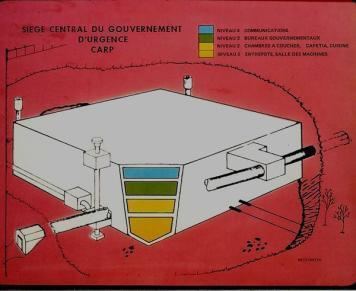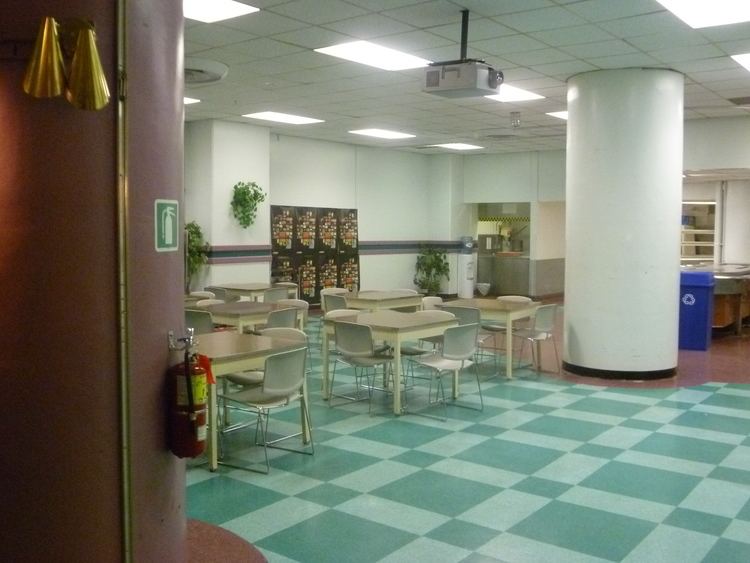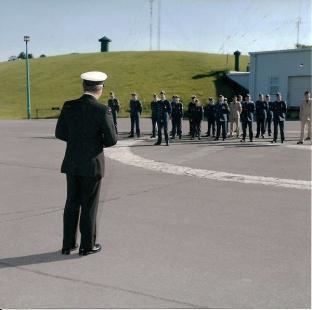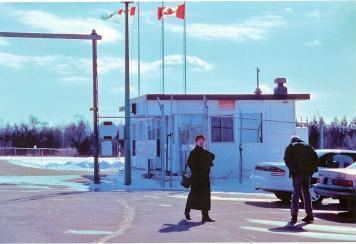Built 1959–1961 Province Ontario Headquarters Ontario, Canada | Opened June 1998 Date founded 1962 Current use Museum | |
 | ||
Location Ottawa, Ontario, Canada Founder Diefenbunker Development Group Original use Emergency Government Headquarters Architect Foundation Corporation of Canada, L. Col. Ed Churchill Governing body Diefenbunker, Canada's Cold War Museum Similar Canada Aviation and Spac, CFS Debert, Canadian War Museum, Canadian Museum of Nature, Billings Estate Museum | ||
Security at cfs carp
Canadian Forces Station Carp (also CFS Carp and commonly known as The Diefenbunker) is a former Canadian military facility located in the rural farming community of Carp, Ontario, approximately 30 km (19 mi) west of downtown Ottawa.
Contents
- Security at cfs carp
- History
- Diefenbunker Canadas Cold War Museum
- Growth
- Collections and research
- Funding
- Additional services
- References

CFS Carp was decommissioned in 1994. It was not until 1998 that it was reopened as a museum and designated a National Historic Site of Canada. Currently, the facility operates as a museum and is open year-round for tours.

History

In 1958, at the height of the Cold War and the infancy of the Intercontinental Ballistic Missile (ICBM) threat, John Diefenbaker, Canada's Prime Minister at the time, authorized the creation of close to 50 Emergency Government Headquarters (called Diefenbunkers by opposition parties) across Canada. These shelters were part of what came to be known as the Continuity of Government plan, which was meant to protect various members of government in the event of a nuclear attack.

The original site, some 9.7 km (6.0 mi) east of Almonte (45°15′06.66″N 076°19′31.05″W) was abandoned when ground water proved impossible to remove. An abandoned gravel pit outside Carp was selected instead, construction began in 1959 and was completed by 1962.
The Carp shelter would be the largest of such facilities (over 9,300 m2 (100,000 sq ft)) and the only one in the immediate Ottawa area. The underground 4-storey bunker required 32,000 tonnes of concrete and 5,000 tonnes of steel. The structure was capable of withstanding a nuclear blast up to 5 megatons from 1.8 km (1.1 mi) away. It had massive blast doors at the surface, as well as extensive air filters to prevent radiation infiltration. Although supposedly effective against surface nuclear detonations, the facility was later found to be vulnerable to conventional Bunker buster bombs developed after its construction, as these bombs had time delay fuses that would detonate after they had penetrated deeply enough underground.
Underground storage was built for food, fuel, fresh water, and other supplies. The bunker was built to accommodate 565 people for up to one month without receiving additional supplies from the outside. It included an emergency broadcast studio for the Canadian Broadcasting Corporation and a vault on the lowest level to hold the gold reserves of the Bank of Canada.
These facilities were administered by the Royal Canadian Corps of Signals (later the Communications and Electronics Branch). A decentralized transmitter site, the Richardson Detachment, with numerous transmitter antenna was located further to the west near Perth Ontario that was supported from a 2 storey underground facility of similar construction to the Carp facility but much smaller. Two radio receiving facilities, the CFS Carp Almonte Detachment and CFS Carp Dunrobin Detachment, with a complete receiving antenna arrays were built in the region but all buildings were above ground.
Diefenbunker, Canada's Cold War Museum
CFS Carp was decommissioned in 1994 following the reduction in the ICBM threat.
From 1959 to 1994, the site was owned and operated by the Government of Canada, Department of National Defence. After the local municipality took control of the facility in 1994, the community took a great interest in the bunker, requesting access to public tours of the facility. The local municipality took control of the facility and a group of local volunteers, recognizing the heritage and tourism value of the Carp Diefenbunker, undertook to open the facility as a cold war museum and conduct public tours. It was purchased by the Diefenbunker Development Group in 1998, and officially opened as a museum. The name of the facility was changed to the Diefenbunker, Canada's Cold War Museum shortly thereafter. It is currently open year-round for public tours.
Many areas of the bunker, including the PM’s Suite, the Emergency Government Situation Centre, the CBC Emergency Broadcasting Studio, the Military Federal Warning Centre, the External Affairs Ministerial Office, the Public Works Minister's Office and the Bank of Canada Vault, are being restored to their operational condition. The rest of the 358 rooms have been converted to exhibits of the Cold War era.
Growth
Upon its opening in 1998, the museum was run completely by volunteers. However, the 5,000 visitors received that year was too much to be handled solely by volunteers.
In 1999, the museum's second year of operation, a curator was hired along with some students. The museum's visitation doubled to 10,000 people that year.
The museum continued to grow into the 2000s. Close to 15,000 visitors passed through the Diefenbunker in 2000. Additional part-time staff was hired throughout the year to keep up with museum maintenance and upkeep. As of 2008, the Diefenbunker averages approximately 25,000 visitors each year. Four full-time staff, nine part-time staff and numerous volunteers work to keep the museum running smoothly. In 2012, the museum had 45,280 visitors. This was one of the highest increases in attendance other than the opening year of the Bunker.
The mandate of Diefenbunker, Canada's Cold War museum is “to increase throughout Canada and the world, interest in and a critical understanding of the Cold War, by preserving the Diefenbunker as a national historic site, and operating a Cold War Museum.
Collections and research
The Diefenbunker houses a collection of Cold War artefacts, an archive and a library, all of which are made available to researchers upon request, and to the general public through the exhibitions.
Funding
The Diefenbunker: Canada’s Cold War museum is a not-for-profit, charitable museum. It is funded privately; the main source of revenue for the museum comes from admission sales (approximately 75% of total revenue). The Diefenbunker actively applies for private, municipal, provincial and federal grants. The museum also relies on the generous support of the community through donations and sponsorship.
Additional services
The Diefenbunker offers additional services on top of public tours. The museum has space available to rent both for events and storage. The decommissioned bunker has been used as a movie set on several occasions, including for The Sum of All Fears and Rulers of Darkness.
